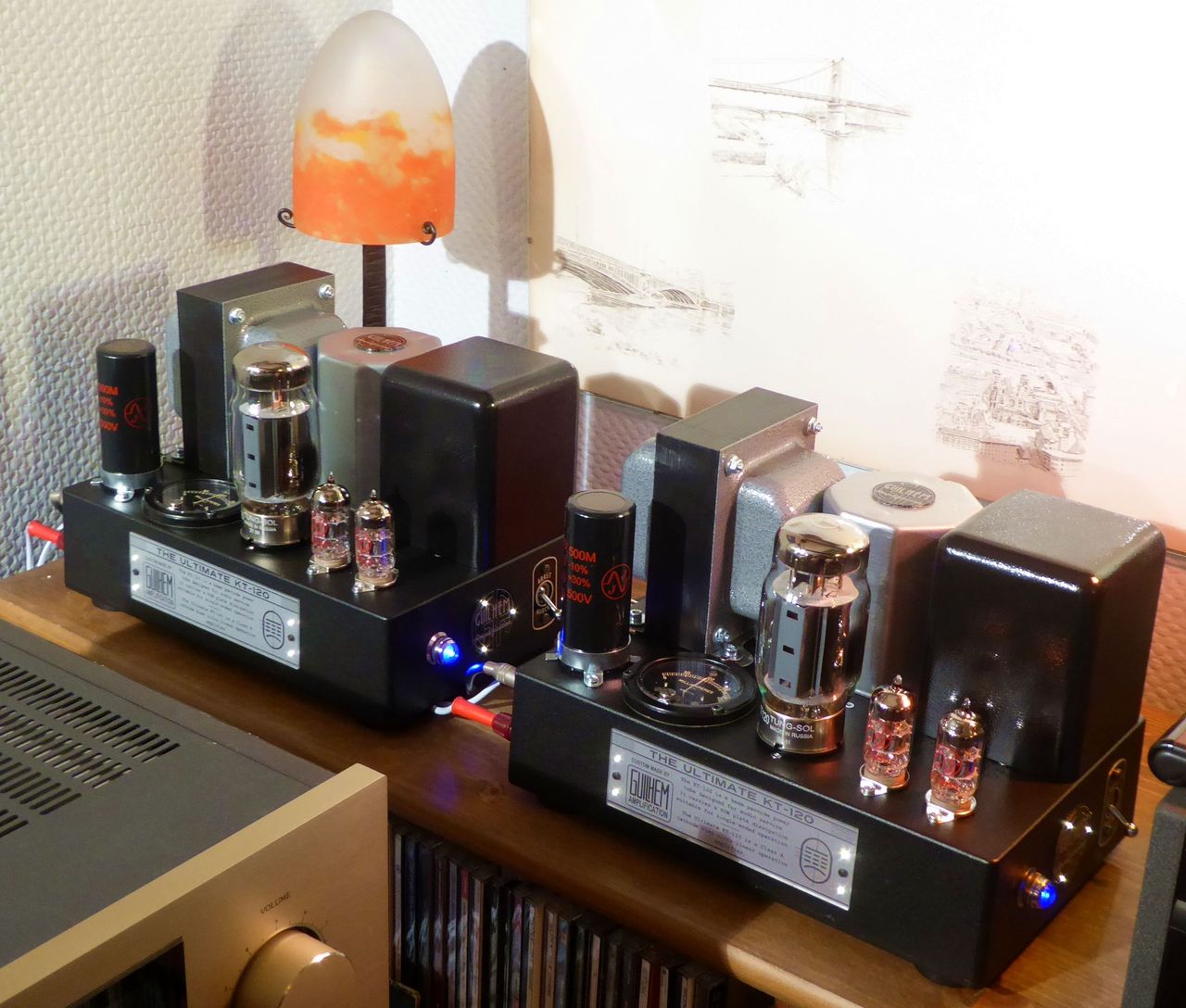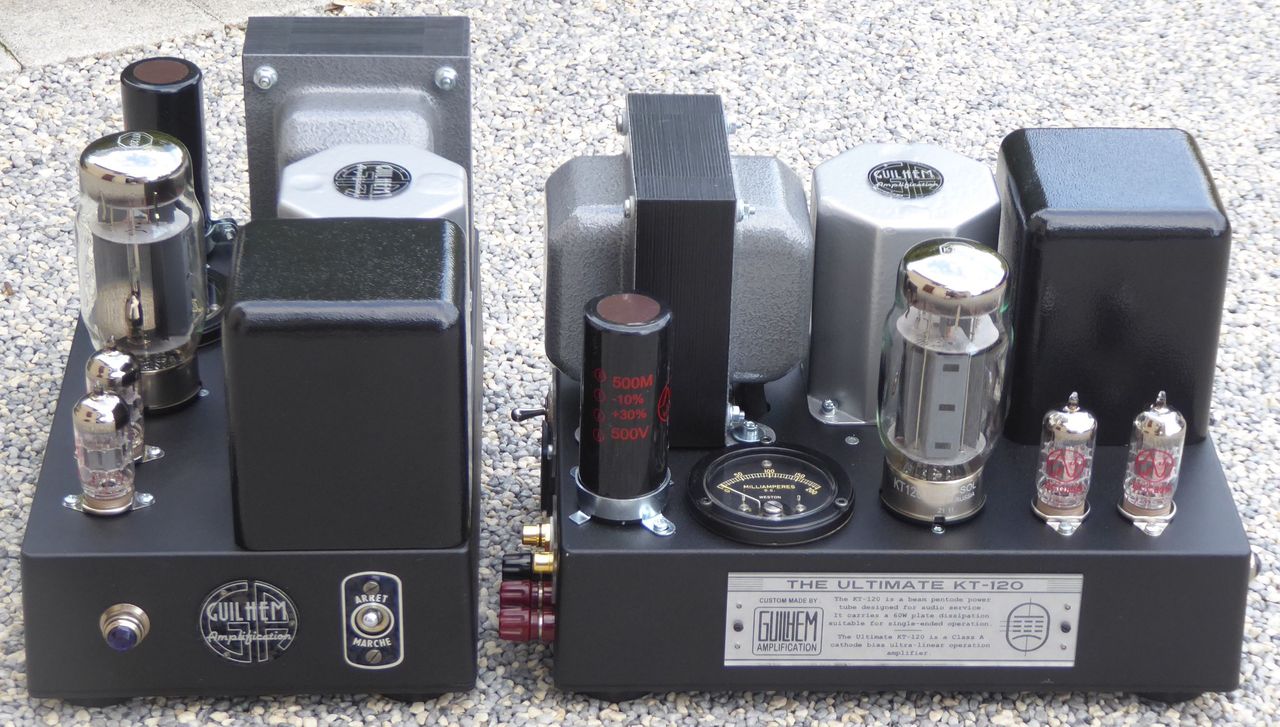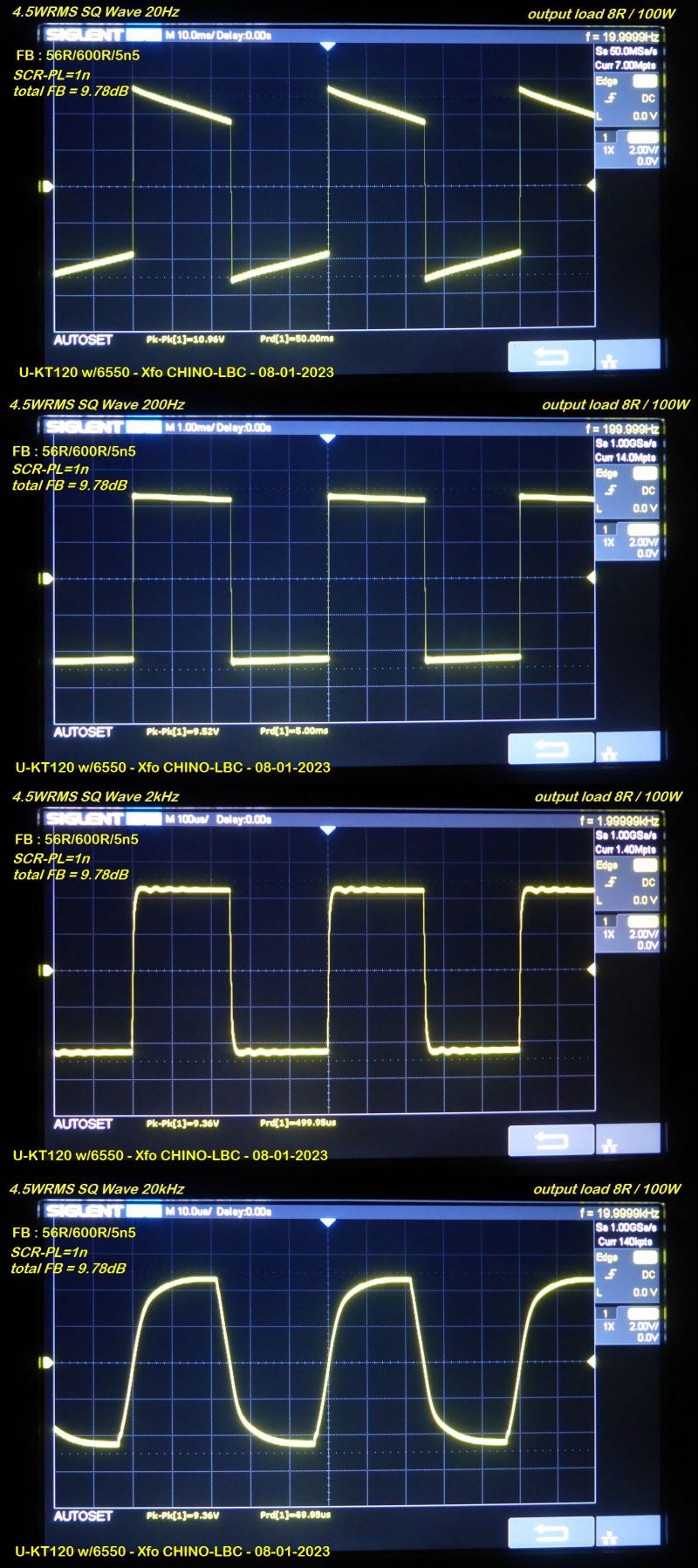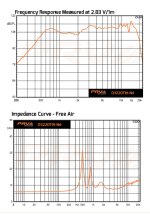That McIntosh looks like it has repurposed modules in it like some of the other class D 2 ch amps. There was a fellow here in Phoenix who sold these "NewClear" brand amps with IcePower modules and a pair of Lundahl xformers to isolate the inputs and inject some pleasant 2nd order harmonics. I personally didn't mind them and actually thought they sounded pretty good through a pair of Tannoy Golds. They weren't however better than anything higher end class A I've heard. Still, very respectable for mostly off the shelf class D.
That McIntosh looks like it has repurposed modules in it like some of the other class D 2 ch amps. There was a fellow here in Phoenix who sold these "NewClear" brand amps with IcePower modules and a pair of Lundahl xformers to isolate the inputs and inject some pleasant 2nd order harmonics. I personally didn't mind them and actually thought they sounded pretty good through a pair of Tannoy Golds. They weren't however better than anything higher end class A I've heard. Still, very respectable for mostly off the shelf class D.
The only class D "wide band" amp that I heard was a 4x900W by Behringer, driving a pair of Magnepan Tympani IV though an active crossover. That Behringer class D amp is in the left rack, second from top - I don't remember the model :
My listening impression was mixed... Of course this amp was capable of the huge power to drive loudly the 84dB/W/m of the Tympani IV, but it seemed somewhat agressive, piercing to my ears in the highs, which were possibly too much set at the forefront ? My friend relied on its microphone + DSP room equalizer... 🤔
When we shifted to my tube amps (on the floor), we had to reinstall the OEM passive crossover of the Tympani IV, and while the power and loudness were inferior (even with the 2x70W KT88 amp at the extreme lower right), I felt that the tone was more balanced and smoother... I wasn't too surprised but, to be honest, since the setup was completely changed, I said to my friend "IMHO, we are comparing Apples and Oranges, you know !". We draw the conclusion that the comparison was... Inconclusive ! 😀
Yes, at least for now, I would not trade my oldies, my tube amps and my Accuphase E-560 (2x30WRMS Pure Class A) for a class D unit...
T
I'd be inclined to agree with you. That behringer is a pro audio amp. Not designed for fidelity but rather cheap, light weight power. There are many better class D designs available, being superior to that cheap noise maker and more representative of better design of the topology. Electrostats are very hard to drive, not only because of low impedance but they're also a horribly capacitive load with lots of bad phase angle.
Being how sensitive our ears are in the midrange, if we were to biamp or even triamp a 3 way setup with a dedicated midrange amp, I'd definitely consider class A for this, mainly because alot of power isn't necessary for decent volume levels. It would be hard to package in a built in modular version just from a cooling perspective alone. You'd probably want 50W to adequately drive the mid with a sensitivity rating of 90+ dB.
Being how sensitive our ears are in the midrange, if we were to biamp or even triamp a 3 way setup with a dedicated midrange amp, I'd definitely consider class A for this, mainly because alot of power isn't necessary for decent volume levels. It would be hard to package in a built in modular version just from a cooling perspective alone. You'd probably want 50W to adequately drive the mid with a sensitivity rating of 90+ dB.
I'd be inclined to agree with you. That behringer is a pro audio amp. Not designed for fidelity but rather cheap, light weight power. There are many better class D designs available, being superior to that cheap noise maker and more representative of better design of the topology. Electrostats are very hard to drive, not only because of low impedance but they're also a horribly capacitive load with lots of bad phase angle.
Being how sensitive our ears are in the midrange, if we were to biamp or even triamp a 3 way setup with a dedicated midrange amp, I'd definitely consider class A for this, mainly because alot of power isn't necessary for decent volume levels. It would be hard to package in a built in modular version just from a cooling perspective alone. You'd probably want 50W to adequately drive the mid with a sensitivity rating of 90+ dB.
Yes, you are right about the Behringer : pro audio, not Hi-Fi / Audiophile category. It was also in 2021. Despite the relative inconclusivity of you test, I guess that there's Class D amps of better quality now - "Hi-Fi / Audiophile compatible", if I can say so...
The Tympani IV are magneplanars, not electrostatics but electrodynamic plane speakers. Conversely to the statics, they are very easy loads for the amplifiers, so the Berhinger had no issue driving them...
Here is for example the impedance and phase curves of the new little Magnepan LRS :
In my 4-ways project, I'll stay passive, but indeed I'll avoid a crossing frequency in the 800-2500Hz, which is the crucial midrange band, where any imbalance, any rupture in tone homogeneity is usually detrimental... I plan to go circa that way :
Beyma 12BR70 ---300-400Hz---> Beyma 8M60N ---3-4kHz---> Satori MD60N ---7-8kHz---> Beyma T2030 or CP21F.
T
Yes, of course... Magnepan... what was I thinking. I had a pair of MGAs a long time ago. Beautiful sounding speakers, especially for classical and jazz. Obviously little to no bass, but what was there just sounded effortless. I drove mine with an older Audio Research VT100 and a krell preamp. Great combination of components.
I also had a pair of Apogee Divas. Those were spectacular examples of full range planars that could also deliver adequate low end. Very hard to drive though. I used a Hafler XL600 with those. The fan drove me a bit nuts with that amp, but it sounded clean and had a really open, but pinpoint soundstage.
Interestingly enough, dome mids can have a similar sound to planars. It must be the low diaphragm mass. Thats probably why I prefer their sound.
I also had a pair of Apogee Divas. Those were spectacular examples of full range planars that could also deliver adequate low end. Very hard to drive though. I used a Hafler XL600 with those. The fan drove me a bit nuts with that amp, but it sounded clean and had a really open, but pinpoint soundstage.
Interestingly enough, dome mids can have a similar sound to planars. It must be the low diaphragm mass. Thats probably why I prefer their sound.
@profiguy
That McIntosh uses Hypex NC500 parts.
Reference:
Hi-FI News
This is the performance from the datasheet NC500 provided to OEMs:

A higher level of performance has been available for DIYers since at least as early as 2012, albeit lower power. We can all thank Bruno Putzeys and Jan-Peter van Amerongen, founder of Hypex. At this time, it had already leapfrogged B&O Icepower, Pascal and Powersoft in terms of lower distortion at moderate amounts of power (20dBW). This is the DIY-only nCore400- not available to OEMs:

So that is 0.0003 THD+N (-110dB) as it approaches 20-80W (4 ohms)
Here's the frequency response showing a -3dB point of about 60KHz:

2 tone IMD:

The latest generation DIY-only product from Hypex is the Nilai500:

The font sizes are a bit small, but as @IamJF pointed out- that is 0.0001 (-120dB) as it approaches 10W- 100W, which is 10dB lower than the nCore400. On the right it approaches hard clipping at 600/400/200W.
The original founder of Hypex, sadly, passed away some years ago. And Bruno now works at Purifi.
This is the latest DIY-friendly product called Eigentakt, model 1ET9040BA:

4 zeros before a significant digit-
0.00003 THD+N is -130dB
@profiguy
Is there someone nearby who can loan you one to you for an extended audition?
I have an anecdote you might find interesting. Some years ago group of us had gotten together for a listening session. We'd had been listening to some user selected favorites tracks from SACD and CDs on a system with a pair of Quad ESL57 and Krell KSA 100. Classics I'm sure you've heard (of).
At some point someone asked to hear "that new digital amp" that I had (they are not, they are analog input, class D). So I dutifully brought in my DIY assembled nCore400. Well, everything was jostling to look at it! I think they were bit disappointed to see a non-descript black box with "a computer power cord?!" Someone even pointed out that the speaker connectors were "not real WBT" connectors. I made all the connections to rear panel and powered it on- if the mob had found that it had a 3mm aluminum rear panel that flexed a little when plugging in the XLR connectors that might have been the end of the show.
I went home thinking- wow- the complete lack of bottom end of the ESL57 just killed the experience for me, having being used to a dynamic dipole setup with equalized sealed woofers...
Anyway, it was quite the listening experience because it revealed a lot to me about pre-conceptions and biases, fixed beliefs, that we ALL have, and how we can be all get used to the typical sound of a speaker, that we can think something sounds wrong when the distortion is lowered, or when channel separation is increased etc...
That McIntosh uses Hypex NC500 parts.
Reference:
Hi-FI News
This is the performance from the datasheet NC500 provided to OEMs:
A higher level of performance has been available for DIYers since at least as early as 2012, albeit lower power. We can all thank Bruno Putzeys and Jan-Peter van Amerongen, founder of Hypex. At this time, it had already leapfrogged B&O Icepower, Pascal and Powersoft in terms of lower distortion at moderate amounts of power (20dBW). This is the DIY-only nCore400- not available to OEMs:
So that is 0.0003 THD+N (-110dB) as it approaches 20-80W (4 ohms)
Here's the frequency response showing a -3dB point of about 60KHz:
2 tone IMD:
The latest generation DIY-only product from Hypex is the Nilai500:
THD+N vs Power into 2Ω, 4Ω and 8Ω
The font sizes are a bit small, but as @IamJF pointed out- that is 0.0001 (-120dB) as it approaches 10W- 100W, which is 10dB lower than the nCore400. On the right it approaches hard clipping at 600/400/200W.
The original founder of Hypex, sadly, passed away some years ago. And Bruno now works at Purifi.
This is the latest DIY-friendly product called Eigentakt, model 1ET9040BA:
4 zeros before a significant digit-
0.00003 THD+N is -130dB
@profiguy
Is there someone nearby who can loan you one to you for an extended audition?
I have an anecdote you might find interesting. Some years ago group of us had gotten together for a listening session. We'd had been listening to some user selected favorites tracks from SACD and CDs on a system with a pair of Quad ESL57 and Krell KSA 100. Classics I'm sure you've heard (of).
At some point someone asked to hear "that new digital amp" that I had (they are not, they are analog input, class D). So I dutifully brought in my DIY assembled nCore400. Well, everything was jostling to look at it! I think they were bit disappointed to see a non-descript black box with "a computer power cord?!" Someone even pointed out that the speaker connectors were "not real WBT" connectors. I made all the connections to rear panel and powered it on- if the mob had found that it had a 3mm aluminum rear panel that flexed a little when plugging in the XLR connectors that might have been the end of the show.
I went home thinking- wow- the complete lack of bottom end of the ESL57 just killed the experience for me, having being used to a dynamic dipole setup with equalized sealed woofers...
Anyway, it was quite the listening experience because it revealed a lot to me about pre-conceptions and biases, fixed beliefs, that we ALL have, and how we can be all get used to the typical sound of a speaker, that we can think something sounds wrong when the distortion is lowered, or when channel separation is increased etc...
Last edited:
@tktran303 Very informative post. Looks like the switching frequency is 120k which is very good. The double hump typically found with class D isn't pronounced, so it may be worth another listen. The specs look good but it may still need some more specific "flavor" in the form of a little 2nd order HD. Their smaller modules may be a good option for bi- and tri-amping.
I have been pleasantly surprised at the very neutral sound from the Hypex FA253 plate amp. I have never listened to a single channel full range, but when used as a 3-channel active amp, it is highly revealing and very neutral. My primary DAC uses a pair of ESS9038Q2M, and my preamp is a Parasound New Classic 200 pre.
does anyone know is there a big dome which extends to at least 15khz?
would like to use it as a dome fullrange in a fast system
would like to use it as a dome fullrange in a fast system
I agree c50 is extraordinary quality.
However I search for a textile dome I could tweak with thin aluminium foil. Something I know how to do. Maybe even sandwich constructionh
However I search for a textile dome I could tweak with thin aluminium foil. Something I know how to do. Maybe even sandwich constructionh
If You intend to modify dome so it doesn't matter what transducer You use anyway. I guess that any 2" dome would do. Cheapest is probably HiVi DMB-A
i cannot influence frequency response if this drops too much in the highs even dsp won't help
20db to correct is too much

20db to correct is too much
Well you can look at some of the hybrid compression drivers with 3" titanium/PEEK suspended diaphragms. The PRV D3220TI (2nd pic) plays well past 10k with the rear chamber removed and reasonably flat. The phenolic diaphragm calls it quits earlier but still very linear. There is also a pure Ti diaphragm available.I agree c50 is extraordinary quality.
However I search for a textile dome I could tweak with thin aluminium foil. Something I know how to do. Maybe even sandwich constructionh
Attachments
Quote below from here as it is freely available and has a lot more graph's and explanations that would be useful to anyone not familiar with this research
https://www.researchgate.net/public..._and_Calibration_of_Sound_Reproducing_Systems
"In the double-blind tests, listeners made bass and treble balance adjustments to a loudspeaker that had been equalized to a flat smooth steady-state room curve."
There is another graphic from one of Olive's headphone presentations that might be helpful to see what was changed vs the speakers native in room response without processing
View attachment 1338099
All the listeners did with the tone controls was undo the EQ that had been applied and bump the bass a bit. Trained listeners don't go for quite as much boom and tizz as the untrained listeners.
I tested the same approach when I was equalizing my line arrays. I equalized the speakers to a flat in room target and then used a parametric EQ with shelving filters spaced an octave apart. I adjusted the gain of the shelving filters until the sound was balanced and then made some other slight modifications by ear until it sounded as good as I could get it. I preferred the bass to level out at 100Hz, I have the same dislike for rising sub bass in the Harman headphone target.
What is silly is to try and take the curve and apply it to all speakers with all different directivities and listening levels and expect it to work the same. It won't.
An approximate 1dB/octave fall in room for an ordinary cone and dome speaker with rising directivity at 80dB or below will sound good. Crank it 10 or 20dB and it won't sound so good, make the directivity much more constant and it won't sound so good.
Have you heard the Revel F208?
An interesting choice because they are quite flat/recessed sounding speakers.The dip in response 2000-3000Hz has been blamed for that.It does not look like much but the lack of presence and projection is very obvious when you hear them.Average punters might like that presentation I suppose because it sounds warm and smooth.I would just call it flat and dull.
No I have not heard any of the Revel speakers. It does have a bit of a soundpower dip at the crossover and the overall response is slighty down sloping perhaps to account for the flat directivity up to 7K.Have you heard the Revel F208?
As You said, You're going to modify it so it doesn't matter. Top of FR is affected almost purely by dome stiffness. If You do some tricks with alu that will make it stiffer so FR on top will change.i cannot influence frequency response if this drops too much in the highs even dsp won't help
20db to correct is too much
View attachment 1338694
How in the world could McIntosh destroy the S/N from an Hypex module to 103dB(A) ... I could achive 129dB(A) with the simple 250W + power supply module.
The more I read about McIntosh and experience their amps (only twice now) - the less I respect this company.
Don't do that 😎
@tktran303 - what was the conclusion of the listening test?
I am with Rupert Neve who told in an interview that electronics have to be silent, with low THD and no humm/noises in the first step so that it is possible to hear fine details (e.g. reverb delay). THEN you do a listening test and compare 1:1.
It's already hard to find a "normal" amp which comes close to these Hypex in terms of noise (you hear a noisefloor when switching and can identify the amps). And I promise it's also hard to find an amp which shows as little influence to the signal sonically as these amps.
You may be used to and/or like some influence of the amp but it's revealing to listen to these Blisema drivers over Hypex modules. But it's not "enveningglassofwinelistening" 🤓
The more I read about McIntosh and experience their amps (only twice now) - the less I respect this company.
You seriously want to compare one of the cheapest PA amps availabel with good HiFi gear and conclude to a whole amplification calss? Like "I heared this chinese €100,- class AB amp with the great big display and it doesn't sound good - all class AB amps must be bad."My listening impression was mixed... Of course this amp was capable of the huge power to drive loudly the 84dB/W/m of the Tympani IV, but it seemed somewhat agressive, piercing to my ears in the highs, which were possibly too much set at the forefront ?
Don't do that 😎
@tktran303 - what was the conclusion of the listening test?
I am with Rupert Neve who told in an interview that electronics have to be silent, with low THD and no humm/noises in the first step so that it is possible to hear fine details (e.g. reverb delay). THEN you do a listening test and compare 1:1.
It's already hard to find a "normal" amp which comes close to these Hypex in terms of noise (you hear a noisefloor when switching and can identify the amps). And I promise it's also hard to find an amp which shows as little influence to the signal sonically as these amps.
You may be used to and/or like some influence of the amp but it's revealing to listen to these Blisema drivers over Hypex modules. But it's not "enveningglassofwinelistening" 🤓
Fwiw I much prefer my Hypex Nilai monoblocks to my Wyred4Sound ice power amp. The ice power sounds "lean", "clinical" in comparison. The Nilais sound great, on the other hand. Nothing really to say about them. They preserve their input without adding anything or taking anything away. It's been my experience that most amps described as "neutral" don't add anything, but do take something away
(My affection for the Nilai's have spurred me to sell off all my other amps, including my pretty awesome class AB Classé DR8 monoblocks which are a close second for me subjectively)
(My affection for the Nilai's have spurred me to sell off all my other amps, including my pretty awesome class AB Classé DR8 monoblocks which are a close second for me subjectively)
You seriously want to compare one of the cheapest PA amps availabel with good HiFi gear and conclude to a whole amplification calss? Like "I heared this chinese €100,- class AB amp with the great big display and it doesn't sound good - all class AB amps must be bad."
Don't do that 😎
Sorry, I am not drawing that kind of Idiophile conclusion, contrary to what you might imagine : you should have read completely what I wrote first.
Sorry, I am also not the kind of tribune who think that when it comes from China and is cheap, it's Junk... I have at least on example :
The output transformer of my DIY Ultimate KT120 Single Ended mono blocks comes from China, unknown brand. I paid 120 Euros for the pair, 2nd Hand :


Looking to the waveforms below, these Chinese transformers could hardly be qualified as Junk per se :

T
- Home
- Loudspeakers
- Multi-Way
- The dome midrange thread

